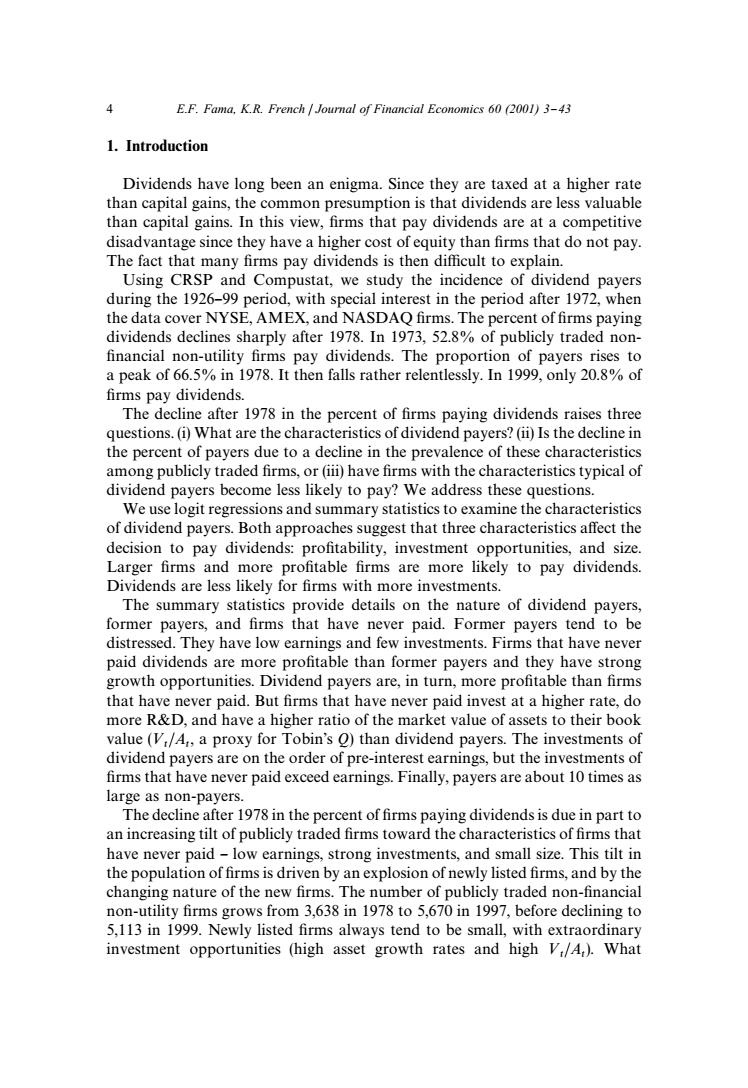正在加载图片...

4 E.F.Fama,K.R.French Journal of Financial Economics 60 (2001)3-43 1.Introduction Dividends have long been an enigma.Since they are taxed at a higher rate than capital gains,the common presumption is that dividends are less valuable than capital gains.In this view,firms that pay dividends are at a competitive disadvantage since they have a higher cost of equity than firms that do not pay. The fact that many firms pay dividends is then difficult to explain. Using CRSP and Compustat,we study the incidence of dividend payers during the 1926-99 period,with special interest in the period after 1972,when the data cover NYSE,AMEX,and NASDAQ firms.The percent of firms paying dividends declines sharply after 1978.In 1973,52.8%of publicly traded non- financial non-utility firms pay dividends.The proportion of payers rises to a peak of 66.5%in 1978.It then falls rather relentlessly.In 1999,only 20.8%of firms pay dividends. The decline after 1978 in the percent of firms paying dividends raises three questions.(i)What are the characteristics of dividend payers?(ii)Is the decline in the percent of payers due to a decline in the prevalence of these characteristics among publicly traded firms,or(iii)have firms with the characteristics typical of dividend payers become less likely to pay?We address these questions. We use logit regressions and summary statistics to examine the characteristics of dividend payers.Both approaches suggest that three characteristics affect the decision to pay dividends:profitability,investment opportunities,and size. Larger firms and more profitable firms are more likely to pay dividends. Dividends are less likely for firms with more investments. The summary statistics provide details on the nature of dividend payers, former payers,and firms that have never paid.Former payers tend to be distressed.They have low earnings and few investments.Firms that have never paid dividends are more profitable than former payers and they have strong growth opportunities.Dividend payers are,in turn,more profitable than firms that have never paid.But firms that have never paid invest at a higher rate,do more R&D,and have a higher ratio of the market value of assets to their book value (V/A,,a proxy for Tobin's O)than dividend payers.The investments of dividend payers are on the order of pre-interest earnings,but the investments of firms that have never paid exceed earnings.Finally,payers are about 10 times as large as non-payers. The decline after 1978 in the percent of firms paying dividends is due in part to an increasing tilt of publicly traded firms toward the characteristics of firms that have never paid-low earnings,strong investments,and small size.This tilt in the population of firms is driven by an explosion of newly listed firms,and by the changing nature of the new firms.The number of publicly traded non-financial non-utility firms grows from 3,638 in 1978 to 5,670 in 1997,before declining to 5,113 in 1999.Newly listed firms always tend to be small,with extraordinary investment opportunities (high asset growth rates and high V/A,).What1. Introduction Dividends have long been an enigma. Since they are taxed at a higher rate than capital gains, the common presumption is that dividends are less valuable than capital gains. In this view, "rms that pay dividends are at a competitive disadvantage since they have a higher cost of equity than "rms that do not pay. The fact that many "rms pay dividends is then di$cult to explain. Using CRSP and Compustat, we study the incidence of dividend payers during the 1926}99 period, with special interest in the period after 1972, when the data cover NYSE, AMEX, and NASDAQ "rms. The percent of "rms paying dividends declines sharply after 1978. In 1973, 52.8% of publicly traded non- "nancial non-utility "rms pay dividends. The proportion of payers rises to a peak of 66.5% in 1978. It then falls rather relentlessly. In 1999, only 20.8% of "rms pay dividends. The decline after 1978 in the percent of "rms paying dividends raises three questions. (i) What are the characteristics of dividend payers? (ii) Is the decline in the percent of payers due to a decline in the prevalence of these characteristics among publicly traded "rms, or (iii) have "rms with the characteristics typical of dividend payers become less likely to pay? We address these questions. We use logit regressions and summary statistics to examine the characteristics of dividend payers. Both approaches suggest that three characteristics a!ect the decision to pay dividends: pro"tability, investment opportunities, and size. Larger "rms and more pro"table "rms are more likely to pay dividends. Dividends are less likely for "rms with more investments. The summary statistics provide details on the nature of dividend payers, former payers, and "rms that have never paid. Former payers tend to be distressed. They have low earnings and few investments. Firms that have never paid dividends are more pro"table than former payers and they have strong growth opportunities. Dividend payers are, in turn, more pro"table than "rms that have never paid. But "rms that have never paid invest at a higher rate, do more R&D, and have a higher ratio of the market value of assets to their book value (< /A , a proxy for Tobin's Q) than dividend payers. The investments of dividend payers are on the order of pre-interest earnings, but the investments of "rms that have never paid exceed earnings. Finally, payers are about 10 times as large as non-payers. The decline after 1978 in the percent of "rms paying dividends is due in part to an increasing tilt of publicly traded "rms toward the characteristics of "rms that have never paid } low earnings, strong investments, and small size. This tilt in the population of "rms is driven by an explosion of newly listed "rms, and by the changing nature of the new "rms. The number of publicly traded non-"nancial non-utility "rms grows from 3,638 in 1978 to 5,670 in 1997, before declining to 5,113 in 1999. Newly listed "rms always tend to be small, with extraordinary investment opportunities (high asset growth rates and high < /A ). What 4 E.F. Fama, K.R. French / Journal of Financial Economics 60 (2001) 3}43